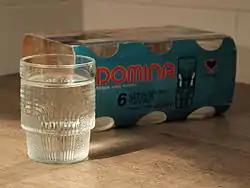
Riihimäki glass (Finnish: Riihimäen lasi) was a reputed glass company in Riihimäki, Finland, in operation from 1910,[1] when it was founded by Mikko Adolf Kolehmainen, to 1990.[2] Their production ranged from basic to high quality[3] glass ornaments, which are now sought after as collectibles, especially some of their vases. Riihimäki products are readily available via collectors' web sites, as are their values.
It produced everyday glassware and art glass until 1976 and cut glass until 1977. After that, it made only machine produced glass and plastic packaging. Ahlstrom Corporation purchased the company in 1980, and closed the Riihimäki plant in 1990.
Among the designers associated with Riihimäki in its early decades were Henry Ericsson, Arttu Brummer, Gunnel Nyman, and after 1945, Tamara Aladin (1959–1976),[4] Greta-Lisa Jäderholm-Snellman, Aimo Okkolin, Sakari Pykälä (1954–1955), Timo Sarpaneva, and Erkkitapio Siiroinen (1968–1976), as well as Helena Tynell.[lower-alpha 1] It was Nanny Still who joined the design team by winning the Nordic art competition the firm held in 1949.[6]
Finnish Glass Museum
Since 1980, the Finnish Glass Museum has been housed in then a glass factory building where Riihimäki Glass started a manufacturing blown glass in 1921. The original owner of that facility was Paloheimo since 1914, which financially supported Riihimäki Glass at its latter stage of operation. The manufacturing at that factory shifted from glass to plastic packaging, then to screen printing.[7]
Footnotes
Note
References
- ↑ Toivola, Urho (1947). The Finland year book. The Finland year book. p. 234. ISBN 9780214200816. OCLC 488618815.
- ↑ Beard, Geoffrey W. (1976). International modern glass. Barrie & Jenkins. p. 103. ISBN 978-0-214-20081-6.
- ↑ Scandinavia. Fodor's. 1964. p. 103. ISBN 9780214200816. OCLC 466905933.
- ↑ Ahtokari, Reijo. Suomen lasiteollisuus 1681–1981 [Finnish glass industry 1681–1981] (in Finnish). Helsingin Liikekirjapaino Oy. pp. 147–158.
- ↑ "Every home vases". Helsingin sanomat. 18 May 2007. Retrieved 14 May 2009.
- ↑ Nevaluoma, Kari-Otso (2008). Satumaista lasia [Fairytale Glass] (in Finnish). Avotakka. pp. 114–119.
- ↑ "Riihimäen Lasi Oy:n työväenasuntoalue ja Suomen lasimuseo" [Riihimäen Lasi Oy's worker housing area and the Finnish Glass Museum]. Rakennettu kulttuuriympäristö (in Finnish). Museovirasto [Finnish Glass Museum]. Retrieved 14 May 2009.
Further reading
- Andy McConnell (2006) 20th-century Glass. Miller's Guides.
- Riihimäen Lasi Oy 1910–1960, Riihimäen lasi 1960, p.172. Historiikin kirjoittanut V. Länsiluoto.
- Annala, Vilho (1948). Suomen lasiteollisuus vuodesta 1681 nykyaikaan. II osa. Kehitys vuoden 1809 jälkeen [The Finnish glass industry from 1681 to the present. Part II. Development after 1809.]. Vol. 2. Helsinki: Suomen lasiteollisuusliitto. pp. 642–697.
- Hoffrén, Jouko ; Penttilä Kalevi. (1979) Riihimäen historia I [History of Riihimäki I], pp.347–359,904–921. Karisto, Hämeenlinna.
External links
- Glass objects made by Riihimäki glass(in Finnish) Designlasi.com